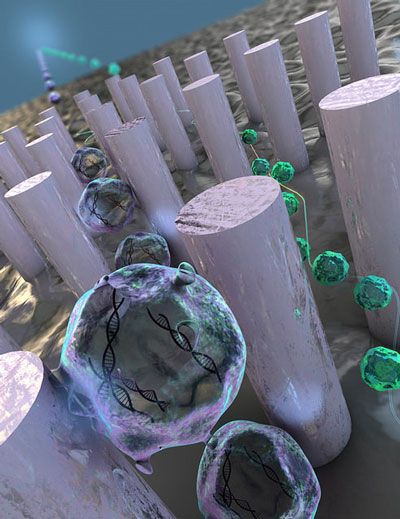Impressive.
3D printing services will grow from $2.5bn in 2013 to $16.2bn in 2018, according to Canalys Tags: 3D printing, Cloud computing.
A single photon can excite two or more atoms at the same time, scientists found. And the light particle would do so in a very counterintuitive way, by summoning one or more companion photons out of nothingness.
If you think of particles of light, or photons, as billiard balls, it makes intuitive sense that a single photon can excite a single atom.
The new, less intuitive finding depends on the strange nature of quantum mechanics, and might help improve advanced machines known as quantum computers, researchers said. Prior work suggested that such machines could simultaneously perform more calculations in one instant than there are atoms in the universe. [Warped Physics: 10 Effects of Faster-than-Light Travel].
More on the new most powerful QC at USC.
Following a recent upgrade, the USC-Lockheed Martin Quantum Computing Center (QCC) based at the USC Information Sciences Institute (ISI) with 1098 qubits, is now the leader in qubit capacity…
USC Viterbi School of Engineering Amy Blumenthal, 917.710.1897 [email protected]
Excellent write up on a paper submitted to the International Association for Cryptologic Research, by a group of UK and Belgian researchers are offering up a dig-sig scheme to assist in the addressing of Digital signatures (one of the fundamental parts of cryptography) in a post-quantum world. Expect the heat to rise on QC security as China’s launch date nears for the new Quantum Satellite.
Boffins smokin’ idea to share parts of keys to cook quantum-proof crypto.
Nice.
When we think of synthetic biology, we often think of engineering a cell to give it some useful function. But SEED 2016 had quite a few speakers working outside of a biological cell. Some broke open cells to utilize just the cellular machinery to create “cell-free” systems. Others showed what could be done inside of the computer (in silico) to improve our understanding and prediction of synthetic gene networks. Here, we’re highlighting SEED speakers who showed how both of these approaches can advance synthetic biology.
Cell-free synthetic biology
Roy Bar-Ziv gave the first keynote at SEED 2016. His group at the Weissman Institute has made tremendous progress toward using cell-free expression that can mimic the behavior of real cells. Over the last 12 years they developed their ‘artificial cells’ using microfluidics and DNA arrayed on 2D substrates as DNA brushes. Each spot of DNA can be programmed the same as DNA in cells, and unlike other cell-free expression setups the microfluidics allows for dynamics.
Nice!
IBM scientists have developed a new lab-on-a-chip technology that can, for the first time, separate biological particles at the nanoscale and could help enable physicians to detect diseases such as cancer before symptoms appear.
As reported today in the journal Nature Nanotechnology (“Nanoscale Lateral Displacement Arrays for Separation of Exosomes and Colloids Down to 20nm”), the IBM team’s results show size-based separation of bioparticles down to 20 nanometers (nm) in diameter, a scale that gives access to important particles such as DNA, viruses and exosomes. Once separated, these particles can be analyzed by physicians to potentially reveal signs of disease even before patients experience any physical symptoms and when the outcome from treatment is most positive. Until now, the smallest bioparticle that could be separated by size with on-chip technologies was about 50 times or larger, for example, separation of circulating tumor cells from other biological components.

Imagine you wake up one morning burning to make the great physicist Max Planck’s face out of copper. (Just go with it.) Sure, you could sculpt it, but there’s a better way. Cut a flat copper sheet into a half-oval, and take a triangle out of the center of its straight edge. Divide it into smaller triangles, bend the sheet so that the two sides of the big triangle touch—and violà! A sheet of flat copper triangles has morphed to match every nook and cranny of Planck’s face. No sculpting required.
If that sounds like magic … well, that’s understandable, because we left a few steps out. Computer scientist Keenan Crane from Carnegie Mellon University actually did this with real copper, and you can see a computer model of the final product at the top of this article. Making Planck’s face wasn’t the point, of course: When Crane cut the sheet into carefully-designed triangles, he brought it into a class of materials known as auxetics, whose curious and complex properties have excited researchers for decades. Someday, auxetics could improve highway shock absorbers, form more comfortable and versatile shoes, and line veins that thicken when expanding.
At least, that’s what the grant applications say. “People give a lot of lip service to how it’s gonna change the world, in terms of curing cancer,” says Crane. “But at this stage people are still trying to figure out just basic questions.” Auxetics all started with a 1987 Science paper by engineer and professor Roderic Lakes. He reported a new kind of polymer foam that contradicted common sense. It expanded in one direction when stretched in another, and contracted in one direction when squeezed in another.
We spend our lives surrounded by hi-tech materials and chemicals that make our batteries, solar cells and mobile phones work. But developing new technologies requires time-consuming, expensive and even dangerous experiments.
Luckily we now have a secret weapon that allows us to save time, money and risk by avoiding some of these experiments: computers.
Thanks to Moore’s law and a number of developments in physics, chemistry, computer science and mathematics over the past 50 years (leading to Nobel Prizes in Chemistry in 1998 and 2013) we can now carry out many experiments entirely on computers using modelling.